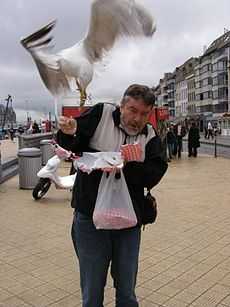Ornithophobia

Ornithophobia is a type of specific phobia, which is an abnormal and irrational fear of birds. The origin of the word ornitho is Greek (meaning bird) and phobia is Greek (meaning fear). The fear of birds is not uncommon, and it stems from the menacing, darker image of some birds of prey. Some people may only fear predatory birds, such as vultures, while others will even be afraid of household pets in the likes of budgies.[1]
Sufferers of this phobia might fear that they will be attacked by a bird or may simply be uncomfortable around them. They would usually fear their fluttering wings, the way they move, the way they fearlessly fly towards people hoping for food, the texture of feathers, the fear of disease or any combination of these. Birds can also be loud, large and menacing, and they can demonstrate little fear of humans.[2]
The phobia itself causes heart palpitations, sweating, nervousness, and avoidance behavior in those who suffer from Ornithophobia. Without treatment the phobia can become life-limiting. The fear of birds has been well-documented in films and poetry.
Cause
Like all animal phobias, ornithophobia is commonly caused by a negative encounter with the feared animal. Many birds can be somewhat aggressive in hunting for food, and childhood run-ins with pigeons or seagulls bent on stealing snacks are common. Many people, whether or not they have a full-blown phobia, are wary of snacking in areas with large bird populations. Birds sometimes fly through open windows or down chimneys, causing an uproar in the home. If the sufferer was nervous in such encounters, this could be enough to trigger a phobia.
Folklore
Throughout centuries, a raven was believed to symbolize the subconscious mind and to evoke feelings of pain and misery, and death seemed evident in its black form and its unflinching gaze. Birds such as ravens are known for their macabre image, and can cause the fear of birds in humans. Many birds, such as vultures, are potent symbols of death. From large gulls that amass in the skies and swoop down suddenly, to falcons, with their predatory eyes, can cause fear and anxiety in human beings.
Symptoms
Ornithophobia can cause the following symptoms: breathlessness, dizziness, excessive sweating, nausea, dry mouth, shaking, heart palpitations, inability to speak or think clearly, a fear of dying, becoming mad or losing control, or a full-blown anxiety attack. When forced to confront a bird, the person might shake, cry or even freeze in place. They may then run away or attempt to hide. They might also experience anticipatory anxiety in the days before a likely confrontation with birds. In phobic individuals, the sight of a grey sky filled with cawing birds can be terrifying.
Most phobias trigger panic attack symptoms in the afflicted, and this is true of the Ornithophobia as well. Persons who become agitated when birds are near tend to stay away from situations where they will be present. As with many animal phobias, just the sight or sound of birds (or even a photo of a bird) can terrify people with this condition. It might also be a fear of being attacked by birds, although this rarely happens.
Effects on life
Birds are widespread throughout the world. It would be nearly impossible to go through an entire day without a single encounter with some type of bird. There are more than 10,000 species around the world and exist on every continent. Thus, it is not uncommon for those with ornithophobia to gradually restrict their activities. They might avoid picnics and other outdoor activities. They may become unable to visit pet stores. Over time, untreated ornithophobia could eventually lead them to become agoraphobic, afraid to leave the house for fear of confronting a bird.
The city can be a frightening place as gulls wait on power lines, and seek out discarded food and bread crumbs from those who enjoy feeding them. Parks and town squares can be common places where the fear of birds is experienced, and the suffers of this phobia will do their best to avoid these locations. Birds, especially pigeons, are a common object of phobic fears. This is a big problem for those who are affected, because birds are highly mobile, and although they seldom if ever enter a building except by accident, they can appear almost anywhere outdoors at any time. People with severe phobias about birds may find themselves confined to their homes, afraid of even opening a window or door, in case a bird should swoop down.
In popular culture
Alfred Hitchcock's horror film The Birds is often used as an example of ornithophobia. Although in the film, the birds do attack humans, so it is rational for the humans to be afraid of the birds. Hitchcock created an atmosphere of horror and unease, aided by the frightening sounds and images of angry, bloodthirsty birds. Lead actress Tippi Hedren was said to be traumatized by the repeated use of live birds in the “attacks” on her character.
Edgar Allan Poe's The Raven, a poem evoked the dark menace, and also the grim, stately beauty of the black raven. Poe is thought to have written this in response to the suffering of his own wife, who was stricken with tuberculosis.
Sheldon Cooper from The Big Bang Theory lists the condition as one of his phobias and even discusses the issue with a small child named Rebecca who shares the condition in the 13th episode of the second season entitled "The Friendship Algorithm". In Season 5, Episode 9, "The Ornithophobia Diffusion", the episode's Sheldon plot centred around his confronting and eventual overcoming of this condition.
See also
- List of phobias
- Herpetophobia
- Zoophobia
- Murophobia
- Nosophobia
- Mysophobia
- Chiroptophobia